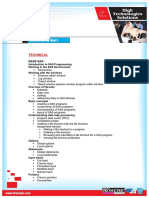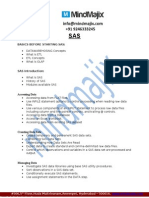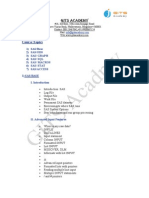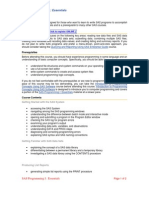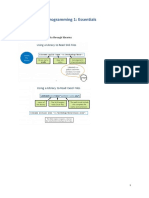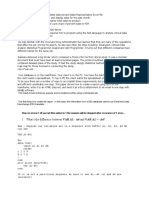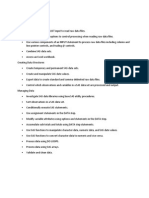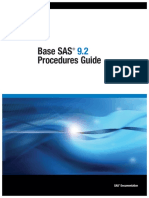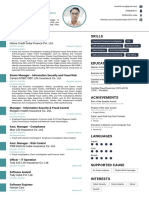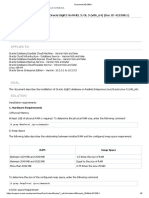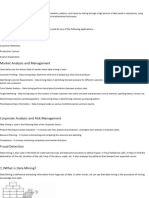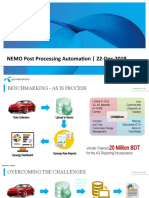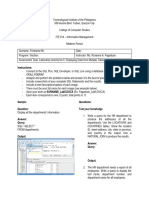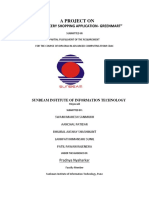Exam Content Guide
SAS 9.4 Advanced Programming – Performance Based Exam
Accessing Data Using SQL
Generate detail reports by working with a single table, joining tables, or using set
operators in SQL
• Use PROC SQL to perform SQL queries.
• Select columns in a table with a SELECT statement and FROM clause.
• Create a table from a query result set.
• Create new calculated columns.
• Assign an alias with the AS keyword.
• Use case logic to select values for a column.
• Retrieve rows that satisfy a condition with a WHERE clause.
• Subset data by calculated columns with the CALCULATED keyword.
• Join tables - inner joins, full joins (coalesce function), right joins, left joins, cross joins.
• Combine tables using set operators - union, outer join, except, intersect.
• Sort data with an ORDER BY clause.
• Assign labels and formats to columns.
Generate summary reports by working with a single table, joining tables, or using set
operators in the SQL.
• Summarize data across and down columns using summary functions (AVG, COUNT,
MAX, MIN, SUM).
• Group data using GROUP BY clause.
• Filter grouped data using HAVING clause.
• Eliminate duplicate values with the DISTINCT keyword.
Construct sub-queries and in-line views within an SQL procedure step.
• Subset data by using non-correlated subqueries.
• Reference an in-line view with other views or tables (multiple tables).
Use special features of the SQL procedure.
• Use SAS data set options with PROC SQL (KEEP=, DROP=, RENAME=, OBS=).
• Use PROC SQL invocation options (INOBS=, OUTOBS=. NOPRINT, NUMBER)
• Use PROC SQL with the SAS Macro Facility to create macro variables with the INTO
keyword.
• Use SAS functions (SCAN, SUBSTR, LENGTH).
• Access SAS system information by using DICTIONARY tables (members, tables,
columns)
1
� Exam Content Guide
Macro Processing
Create and use user-defined and automatic macro variables within the SAS Macro
Language.
• Define and use macro variables.
• Use macro variable name delimiter. (.)
• Use INTO clause of the SELECT statement in SQL.
• Use the SYMPUTX routine in a DATA Step.
• Control variable scope with:
o %GLOBAL statement
o %LOCAL statement
o SYMPUTX scope parameter
Automate programs by defining and calling macros using the SAS Macro Language.
• Define a macro using the %MACRO and %MEND statements.
• Insert comments into macros.
• Pass Information into a macro using parameters.
• Generate SAS Code conditionally by using the %IF-%THEN-%ELSE macro statements or
iterative %DO statements.
Use macro functions.
• Use macro character functions. (%SCAN, %SUBSTR, %INDEX, %UPCASE)
• Use macro quoting functions. (%NRSTR, %STR)
• Use macro evaluation functions. (%EVAL)
• Use %SYSFUNC to execute DATA step functions within the SAS Macro Language.
Debug macros.
• Trace the flow of execution with the MLOGIC option.
• Examine the generated SAS statements with the MPRINT option.
• Examine macro variable resolution with the SYMBOLGEN option.
• Use the %PUT statement to print information to the log.
Create data-driven programs using SAS Macro Language.
• Create a series of macro variables.
• Create a macro variable containing a delimited list of values using PROC SQL.
• Use indirect reference to macro variables. (&&, etc)
• Generate repetitive macro calls using:
o the %DO loop,
o SQL query with SELECT INTO
o DATA Step with DOSUBL or the EXECUTE routine function.
2
� Exam Content Guide
Advanced Techniques
Process data using 1 and 2 dimensional arrays.
• Define and use character arrays.
• Define and use numeric arrays.
• Create variables with arrays.
• Reference arrays within a DO loop.
• Specify the array dimension with the DIM function.
• Define arrays as temporary arrays.
• Load initial values for an array from a SAS data set.
Process data using hash objects
• Declare hash and hash iterator objects
o Dataset argument
o Ordered argument
o Multidata argument
• Use hash object methods
o definekey()
o definedata()
o definedone()
o find()
o add()
o output()
• Use hash iterator object methods
o first()
o next()
o last()
o prev()
• Use hash objects as lookup tables.
• Use hash objects to create sorted data sets.
• Use hash iterator objects to access data in forward or reverse key order.
Use SAS utility procedures
• Specify a template using the PICTURE statement within the FORMAT Procedure
o Specify templates for date, time, and datetime values using directives.
o Specify templates for numeric values using digit selectors.
• Create custom functions with the FCMP procedure
o Create character and numeric custom functions with single or multiple
arguments.
o Create custom functions based on conditional processing.
o Use custom functions with the global option CMPLIB=.
3
� Exam Content Guide
Note: All 12 main objectives will be tested on every exam. The 62 expanded objectives are
provided for additional explanation and define the entire domain that could be tested.







